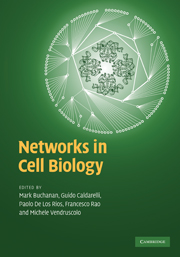Book contents
- Frontmatter
- Contents
- List of contributors
- Introduction
- 1 Network views of the cell
- 2 Transcriptional regulatory networks
- 3 Transcription factors and gene regulatory networks
- 4 Experimental methods for protein interaction identification
- 5 Modeling protein interaction networks
- 6 Dynamics and evolution of metabolic networks
- 7 Hierarchical modularity in biological networks: the case of metabolic networks
- 8 Signalling networks
- Appendix A Complex networks: from local to global properties
- Appendix B Modelling the local structure of networks
- Appendix C Higher-order topological properties
- Appendix D Elementary mathematical concepts
- References
- Index
Appendix D - Elementary mathematical concepts
Published online by Cambridge University Press: 05 June 2012
- Frontmatter
- Contents
- List of contributors
- Introduction
- 1 Network views of the cell
- 2 Transcriptional regulatory networks
- 3 Transcription factors and gene regulatory networks
- 4 Experimental methods for protein interaction identification
- 5 Modeling protein interaction networks
- 6 Dynamics and evolution of metabolic networks
- 7 Hierarchical modularity in biological networks: the case of metabolic networks
- 8 Signalling networks
- Appendix A Complex networks: from local to global properties
- Appendix B Modelling the local structure of networks
- Appendix C Higher-order topological properties
- Appendix D Elementary mathematical concepts
- References
- Index
Summary
A primer on statistics and probability theory
This section provides an overview of some of the statistical tools and concepts which are useful for data analysis and the study of complex networks. Our emphasis will be on the practical application of probability theory, rather than its mathematical foundations, which is why we will confine ourselves to self-consistent definitions of the basic ingredients of applied statistics, rather than their derivation from first principles. For those who desire a more rigorous and more detailed treatment of the material, a celebrated introduction to probability theory can be found in, which discusses the contents of this chapter in much greater detail.
Events and probabilities
Tossing a coin – with an outcome of ‘heads’ or ‘tails’ – is one of the simplest examples of a probabilistic event. More complicated examples could be to obtain ‘five’ and ‘two’ when throwing a pair of dice, the ball landing on a red number in a game of roulette, or the spreading of an infection from an infected individual to a healthy one. In all these cases the set of all possible outcomes of an experiment is the sample space. An event can be defined as any member (or subset) of the sample space.
Technical part In set theory we can write that very simply: Ω is the sample space and any set A ⊂ Ω is an event in the following sense.[…]
- Type
- Chapter
- Information
- Networks in Cell Biology , pp. 219 - 234Publisher: Cambridge University PressPrint publication year: 2010



